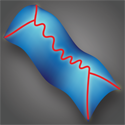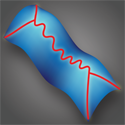Waking up the quantum vacuum
Quantum field theory describes all fundamental interactions between matter except for the most familiar interaction, that of gravity, since a full theory of quantum gravity has yet to be formulated. In an approximation to such a theory, the behavior of the quantum fields describing matter and its nongravitational interactions can be investigated by assuming that they propagate in a classical background spacetime. These fields will in turn affect the background metric, but such “back-reaction” effects are thought to be small as long as one is not dealing with an extreme situation, such as near a singularity.
However, in an article appearing in Physical Review Letters, authors William Lima and Daniel Vanzella, both of the University of Sao Paulo, Brazil, show that even in some “nonextreme” situations the quantum fluctuations of these fields can have large effects on the background metric. They consider a free scalar field that is coupled to the scalar curvature and propagating in a metric that is conformally flat in the asymptotic past and conformally static in the asymptotic future. They find, under some specific but reasonable conditions, that the background metric forces the vacuum fluctuations to increase without bound as the field propagates into the future. As a result, the field’s vacuum energy density will eventually dominate its classical energy density.
The authors speculate that this “vacuum-dominance” effect might have unexpected implications in astrophysical settings (such as neutron stars) and in cosmology. In a cosmological setting, they estimate that the “asymptotic future” where this effect cuts in is of the order of ten billion years, but for a neutron star it may be as short as microseconds. – Jerome Malenfant





